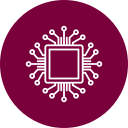GenAI for Learners
What benefits, if any, does generative AI pose for student learning? What learning outcomes could its use support or enhance? This chapter assumes your familiarity with the risks and challenges of generative AI for post-secondary (e.g. academic integrity, assessment design, hallucinations) and imagines what benefits there might be and what opportunities there are for preparing students for a generative AI supported learning experience.
You can think of the possibilities in two domains:
- supporting personalized learning and
- generating academic content
With respect to generating academic content or performing academic skills, you want to think carefully about what the core learning outcomes are for the course, and whether and how students can demonstrate these outcomes. Those skills or knowledge that are not essential to the core learning outcomes might be appropriate for ‘cognitive offloading’ to a generative AI tool. Cognitive offloading refers to the use of external resources or tools to change the information processing requirements of a task so as to reduce cognitive demand.[1]
For instance, if your course learning outcomes require students to demonstrate abilities to generate multiple hypotheses to explain a phenomenon, using generative AI to generates these hypotheses would be inappropriate. However, if your course learning outcomes were focused on having students test a hypothesis it in a laboratory setting, having a generative AI tool generate the hypothesis which the student would then test would be an example of appropriate cognitive offloading.
Supporting Personalized Learning
Invite students to use a generative AI tool to:
Consider the following student uses of GenAI to assist them in their learning:
 Understanding: Students can ask the GenAI (like ChatGPT) to reword the description of a new concept (in a language of their choice), to draw up the concept or concept map or flowchart, provide examples, and keep doing this under they understand. The GenAI is infinitely patient and can adapt to a student’s preferred mode of understanding (e.g., by using analogies to help the student understand).
Understanding: Students can ask the GenAI (like ChatGPT) to reword the description of a new concept (in a language of their choice), to draw up the concept or concept map or flowchart, provide examples, and keep doing this under they understand. The GenAI is infinitely patient and can adapt to a student’s preferred mode of understanding (e.g., by using analogies to help the student understand).- Practice: The GenAI can create practice problem sets and adapt them to the learner’s understanding, adding more practice in areas where the student’s grasp appears to need more practice, and stepping up the difficulty as the student gains strength.
- Feedback: GenAI can be used to provide personalized feedback to learners on their work. Using a prompt that specifies what criteria to focus on, the GenAI can review each student’s work and make suggestions about where to continue working to improve the work. Students must be aware of privacy issues associated with the tools and should refrain from inputting any personal information into the GenAI tool.
- Open Mindsets: Ask students to consult a GenAI to present an alternative view to their position or to poke holes in their argument. Humans tend to become entrenched in a position, and the GenAI can provide a wider perspective that helps learners see other points of view. (see for example Ethan Mollick’s article Thinking companion, companion for thinking)
- Coach: The GenAI can guide a learner to do a complex task by providing instructions and taking students through these instructions, one step at a time. For example, the GenAI can help students create an outline and then work from that outline one paragraph at a time to write an essay.
- Critical Thinking: Current GenAI output are far from perfect. Though impressive, they are often imprecise (they offer general responses), often inaccurate, and they reproduce the bias in the data upon which it was trained (e.g., if you ask a GenAI to draw a leader, they will tend to draw men). Asking students to critically evaluate the GenAI’s output, making them aware of these limitations, and exercising their critical thinking skills, can ensure that they use GenAI as a tool, rather than depending on it to do the work for them. They stay in control of the GenAI when they use it.
- Digital Literacy: Most experts agree that GenAI is here to stay. The fact that Microsoft is working to integrate it into its software means that it will soon become ubiquitous. It is a new tool that will be integrated into many industries. Students need to learn how to use it effectively and responsibly. This means that teaching them to use GenAI is important, as are the metacognitive skills to continue developing these skills (e.g., asking them to reflect on the effectiveness of their prompt and how they could formulate it better).
Here is an infographic summarizing some uses for students that do not violate most academic integrity policies. It also provides specific prompts for each use.

Generating Academic Content
Invite students to use a generative AI tool to:
Expand or condense text
(e.g., expand bullet points to actual text) or condense longer text into shorter text (e.g., condense text into bullet points). A related function is to use AI to summarize the key points from a text, including academic articles. Example.
Brainstorm / Generate ideas
AI can be a useful starting point for students working to identify questions, topics, themes or arguments. A generative AI tool can also be asked to provide counter-arguments for a student-generated idea, that the student then needs to account for in their own work.
Find sources or references
This is a capability where you have to be extra careful. As we know, generative AI tools can “hallucinate” sources that do not exist. Generative AI tools that are integrated in search engines generally perform better at this task. Regardless of the tool used, it’s good practice to verify that any sources identified actually exist. Example.
Identify and analyze data
AI tools can analyze different datasets and structure tables with information based on inputted text or data samples with specific parameters offered Example.
Interact with spreadsheets
Generative AI tools like ChatGPT can easily read the .csv format. You can extract a CSV file and give it to ChatGPT to work with based on certain specifications (e.g., give me an overview of what’s in this CSV file and provide some insights into the information provided), as well as output a CSV file. Example.
Code with natural language prompts
Complete partially written code with suggestions, or translate code from one programming language to another. Example.
With all of these uses it’s important to remind students that what the generative AI tool generates may have hallucinations or biases. Students should be reminded to review and evaluate the output from the generative AI tool to ensure its accuracy and evaluate its effectiveness.
You may be wondering – or your students may wonder – what generative AI tool to use for these tasks. This review essay by Ethan Mollick summarizes the capabilities of the major generative AI tools and makes suggestions on the best tool to use for a specific task. You can also visit “There’s an AI for That” to find new generative AI tools for specific educational tasks.
Ethan Mollick wrote the excellent article Assigning AI: Seven Ways of Using AI in Class, which provides an excellent (and highly recommended) overview of seven ways in which a GenAI can be used by students in class. This includes not only the use that students make of the GenAI (e.g., to receive feedback on work, to coach them through steps), but also the wording of the prompts to use to get the best result.
Learner Perceptions of GenAI
Since the launch of ChatGPT in November 2022, there have been a few small-scale studies to investigate student use and perceptions of generative AI, many with the aim of describing different levels of experience and different perspectives among students. Unsurprisingly, students, like instructors, evince a wide range of reactions and uses of generative AI. Our purpose here is to use the limited available understanding of student use and perception to inform McMaster’s guidelines and resources for students, while also recognizing a need for further investigation and partnership with students to explore the nuances of student perceptions of generative AI.
Attributions
This page has been adapted from:
Generative Artificial Intelligence in Teaching and Learning at McMaster University Copyright © 2023 by Paul R MacPherson Institute for Leadership, Innovation and Excellence in Teaching is licensed under a Creative Commons Attribution 4.0 International License
Note: Images created using DALL-E in August 2023.

